Effect of Notch Structure and Notch Bottom Diameter on the Tensile Load of a Certain GH4169 Notch Bolt for a Device for Longitudinal Separation of Fairing
Abstract
:1. Introduction
2. Establishment of the Simulation Model
2.1. Establishment of the Finite Element Model (FEM)
2.2. Material Properties
2.3. Gridding
2.4. Boundary Conditions and Loads
2.5. Yield Criterion and Hardening Criterion
2.5.1. Yield Criterion
2.5.2. Hardening Criterion
3. Simulation of the Effect of the Notch Structure on the Tensile and Shear Loads
3.1. Tensile Loads of Different Notch Structures
3.2. Shear Loads of Different Notch Structures
3.3. Effect of the Stamping Velocity on Forming
4. Tensile Simulation Analysis of Arc-Shaped Notch Bolts with Different Bottom Diameters
4.1. Tensile Strength Analysis of Notch Bolts with Different Bottom Diameters
4.2. Determination of the Notch Diameter for Different Tensile Strength Ranges
5. Experimental Verification
6. Conclusions
Author Contributions
Funding
Data Availability Statement
Conflicts of Interest
References
- Ren, D.H. An Explosion Separation Device for Longitudinal Separation of the Fairing. Chinese Patent CN2013101728026A, 11 September 2013. [Google Scholar]
- Yang, Z.D.; Gu, H.; Zhang, G.S.; Deng, C. Study on the brittle fracture of 30CrMnSiNi2A bolts. Chin. Equip. Eng. 2018, 10, 73–75. [Google Scholar]
- Fang, J.; Wu, M.; Zhang, T.; Tao, Y.; Liu, J.; Jin, K. Hot forging process on superalloy GH4169 bolt. Forg. Press. Technol. 2022, 47, 8–22. [Google Scholar]
- Tang, T.; Wang, R. Numerical simulation and parameter optimization on hot upsetting for GH4169 alloy dodecagonal heat bolt. Forg. Press. Technol. 2021, 46, 20–26. [Google Scholar]
- Yang, Z.Y. Research on Stress Relaxation Behavior and Finite Element Simulation of GH4169 Alloy; Harbin Institute of Technology: Harbin, China, 2020. [Google Scholar]
- Gao, S.Y.; Wang, Y.W.; Su, R. Low-Cycle fatigue behavior of GH4169 superalloy. Rare. Met. 2022, 46, 289–296. [Google Scholar]
- Yang, H. Research on Fracture Characteristics of Explosive Bolts Based on Finite Elements; Harbin Institute of Technology: Harbin, China, 2017. [Google Scholar]
- Zhang, F.; Yang, S.B.; Yang, A.M.; Wu, R.D. A low-impact separating bolt design. Fireworks 2006, 3, 14–22. [Google Scholar]
- Lin, W.Y. Finite Element Analysis of High Strength Bolted Connections with High Temperature Mechanical Properties; Wuhan University of Technology: Wuhan, China, 2006. [Google Scholar]
- Du, L.F.; Ma, Y.H.; Chen, H.N.; Yang, S.B.; Xia, D.X. The simulation of action procedure of explosive bolt. Fireworks 2015, 3, 29–32. [Google Scholar]
- Yang, C.C.; Ma, L.; Wang, J.D.; Zhao, Y.N.; Yu, Y. Assembly method of carrier rocket interstage separation explosion bolts. Qualit. Reliat. 2018, 2, 13–15. [Google Scholar]
- Song, X.C. Experimental study on mechanical properties of notch bolt under lubricating states. J. Hunan. Inst. Technol. (Nat. Sci. Ed.) 2005, 18, 42–45. [Google Scholar]
- Antolovich, S.D.; Armstrong, R.W. Plastic strain localization in metals: Origins and consequences. Prog. Mater. Sci. 2014, 59, 1–160. [Google Scholar] [CrossRef]
- Wang, S.; Liu, Y.; Peng, H.; Lu, X.; Wang, J.; Su, X. Microstructure and Mechanical Properties of Al–12.6Si Eutectic Alloy Modified with Al–5Ti Master Alloy. Adv. Eng. Mater. 2017, 19, 105–109. [Google Scholar] [CrossRef]
- Li, Y.S.; Tao, N.R.; Lu, K. Microstructural evolution and nanostructure formation in copper during dynamic plastic deformation at cryogenic temperatures. Acta Mater. 2008, 56, 230–241. [Google Scholar] [CrossRef]
- Zhang, Y.; Zhou, Y.J.; Lin, J.P.; Chen, G.L.; Liaw, P.K. Solid-Solution Phase Formation Rules for Multi-component Alloys. Adv. Eng. Mater. 2008, 10, 534–538. [Google Scholar] [CrossRef]
- Liu, M.H.; Li, C.M.; Wang, C.C.; Luo, X.C. The Compression Analysis of LGJ-300/40 Wire Splicing Sleeve. Northeast Powr. Technol. 2014, 35, 26–29. [Google Scholar] [CrossRef] [Green Version]
- Dong, X.H.; Cheng, S.; Tu, T.C.; Zeng, C.; Wu, J. Simulation analysis of compression and tensile fracture of large section wire with steel core and aluminum strand. Elec. Meas. Technol. 2021, 44, 62–69. [Google Scholar]
- Jácome, L.A.; Weber, S.; Leitner, A.; Arenholz, E.; Bruckner, J.; Hackl, H.; Pyzalla, A.R. Influence of Filler Composition on the Microstructure and Mechanical Properties of Steel—Aluminum Joints Produced by Metal Arc Joining. Adv. Eng. Mater. 2009, 11, 350–358. [Google Scholar] [CrossRef]

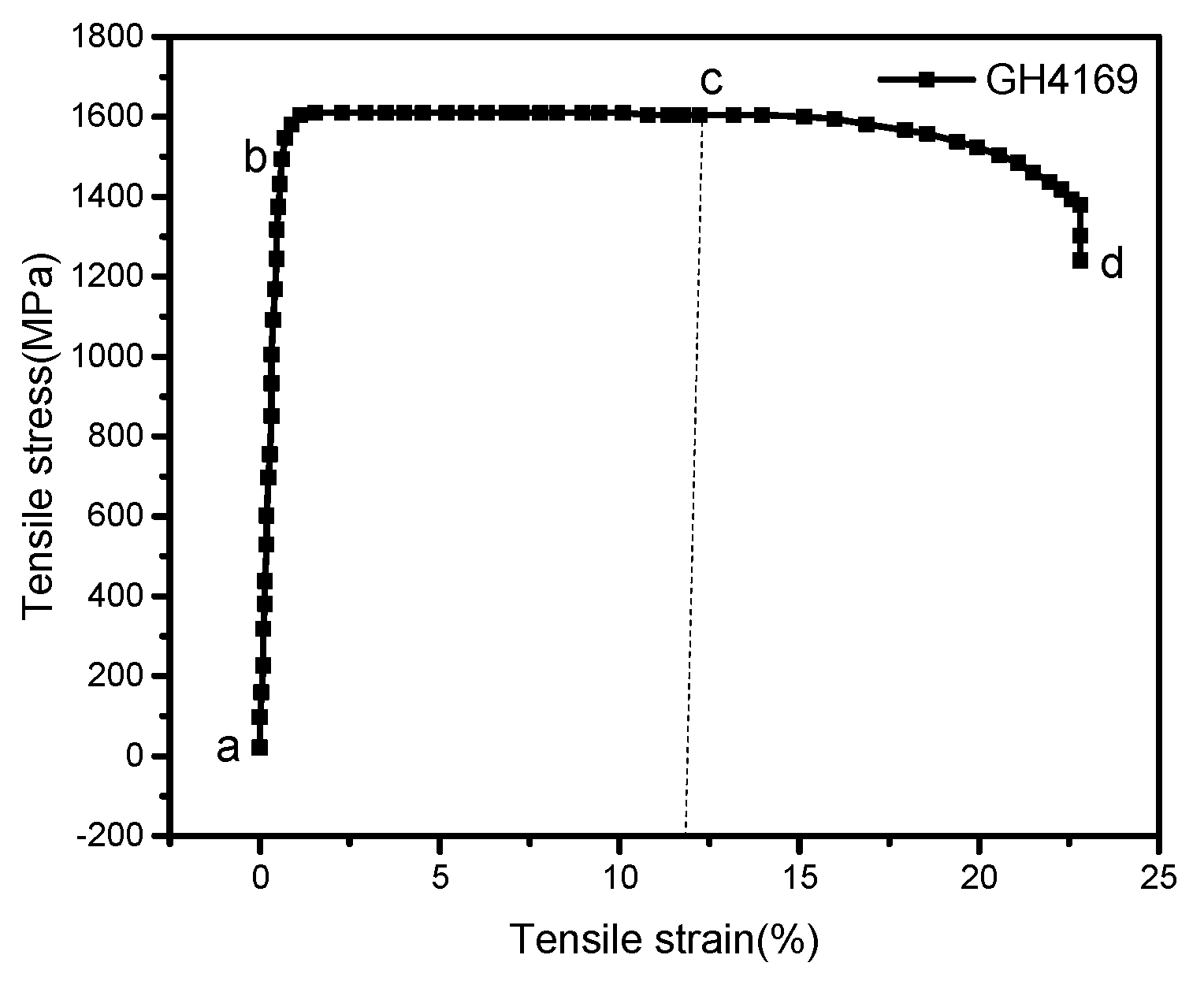
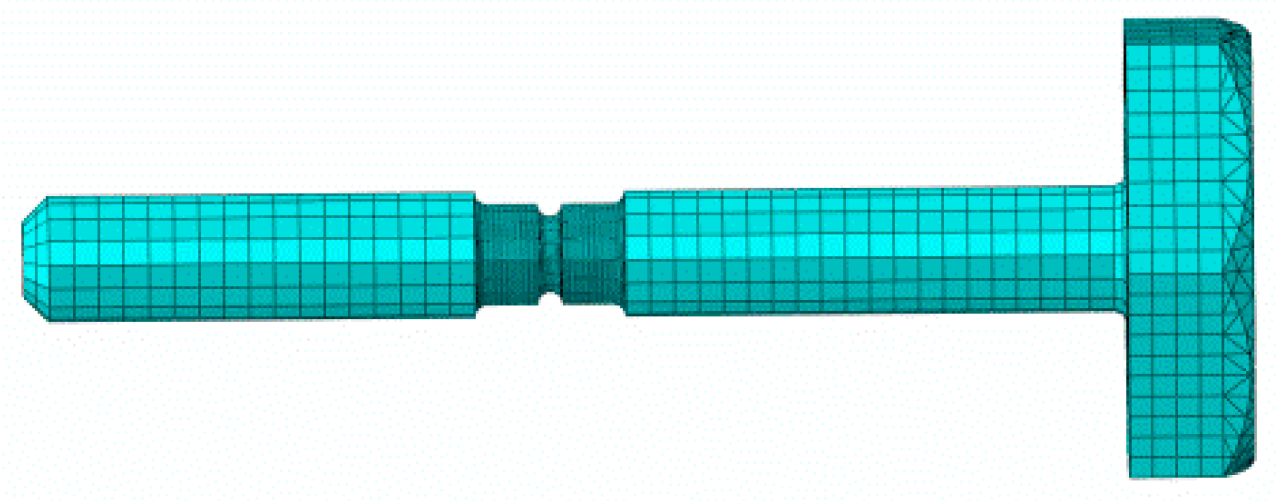
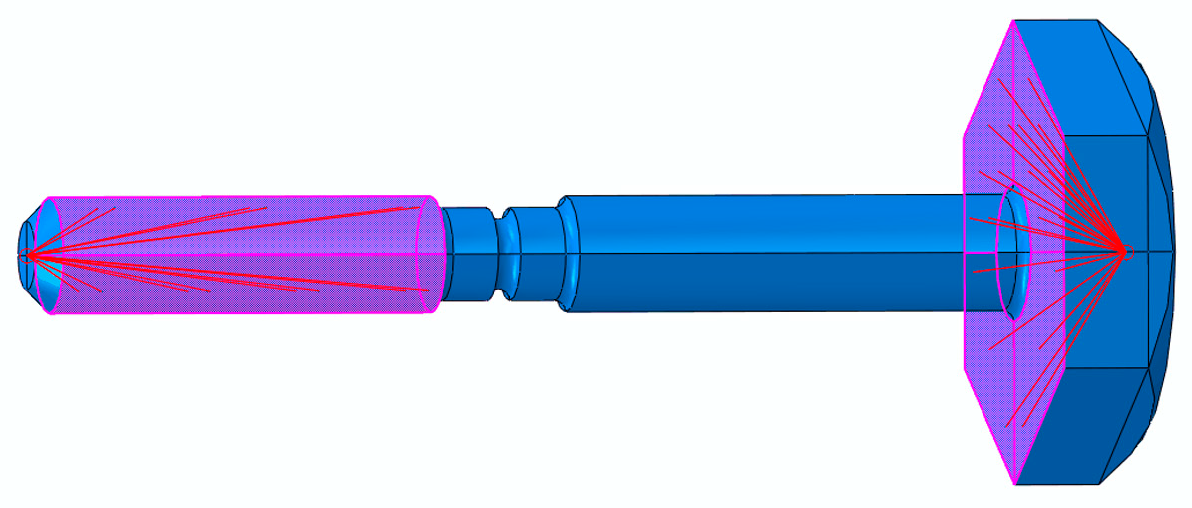
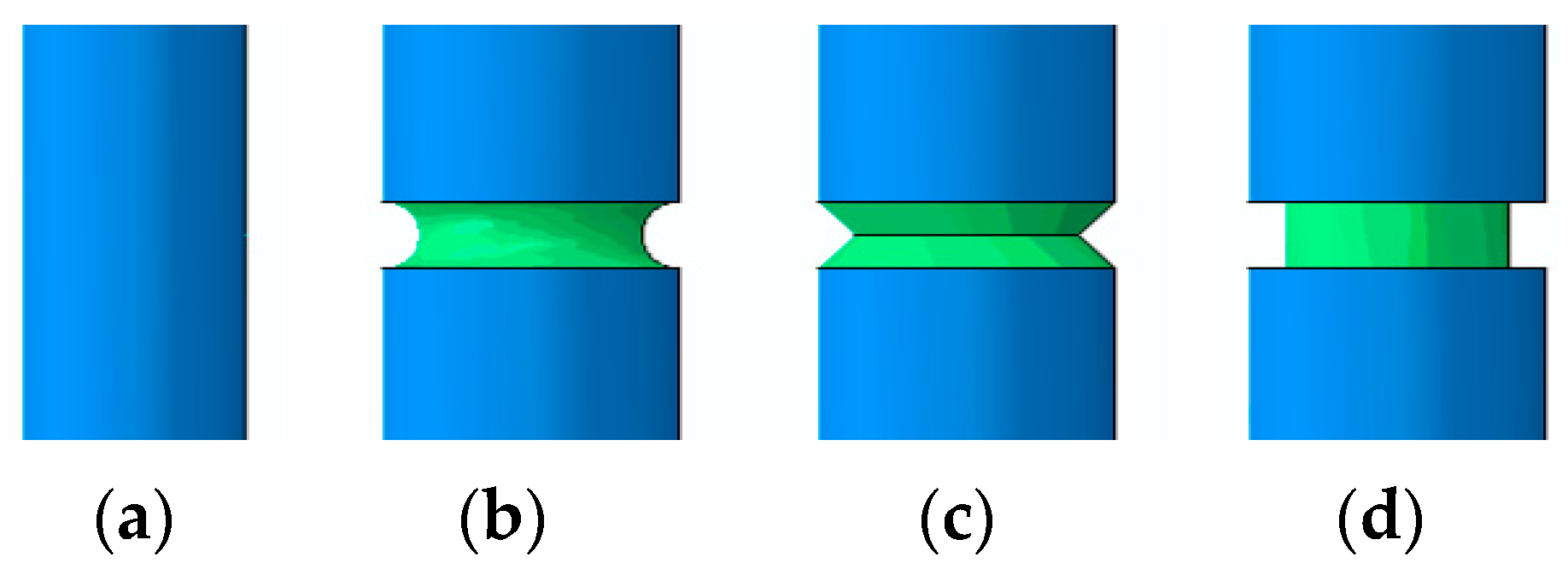
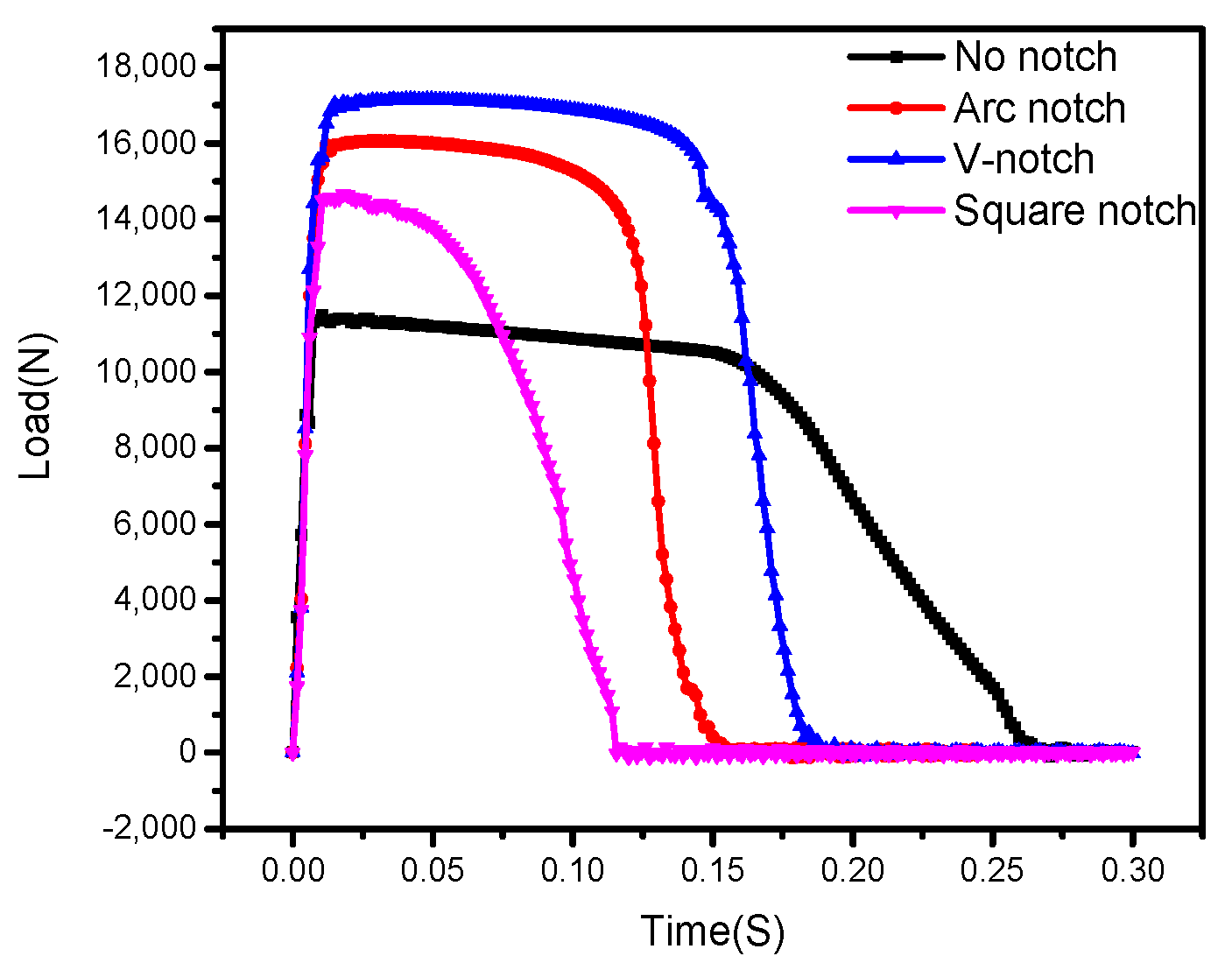
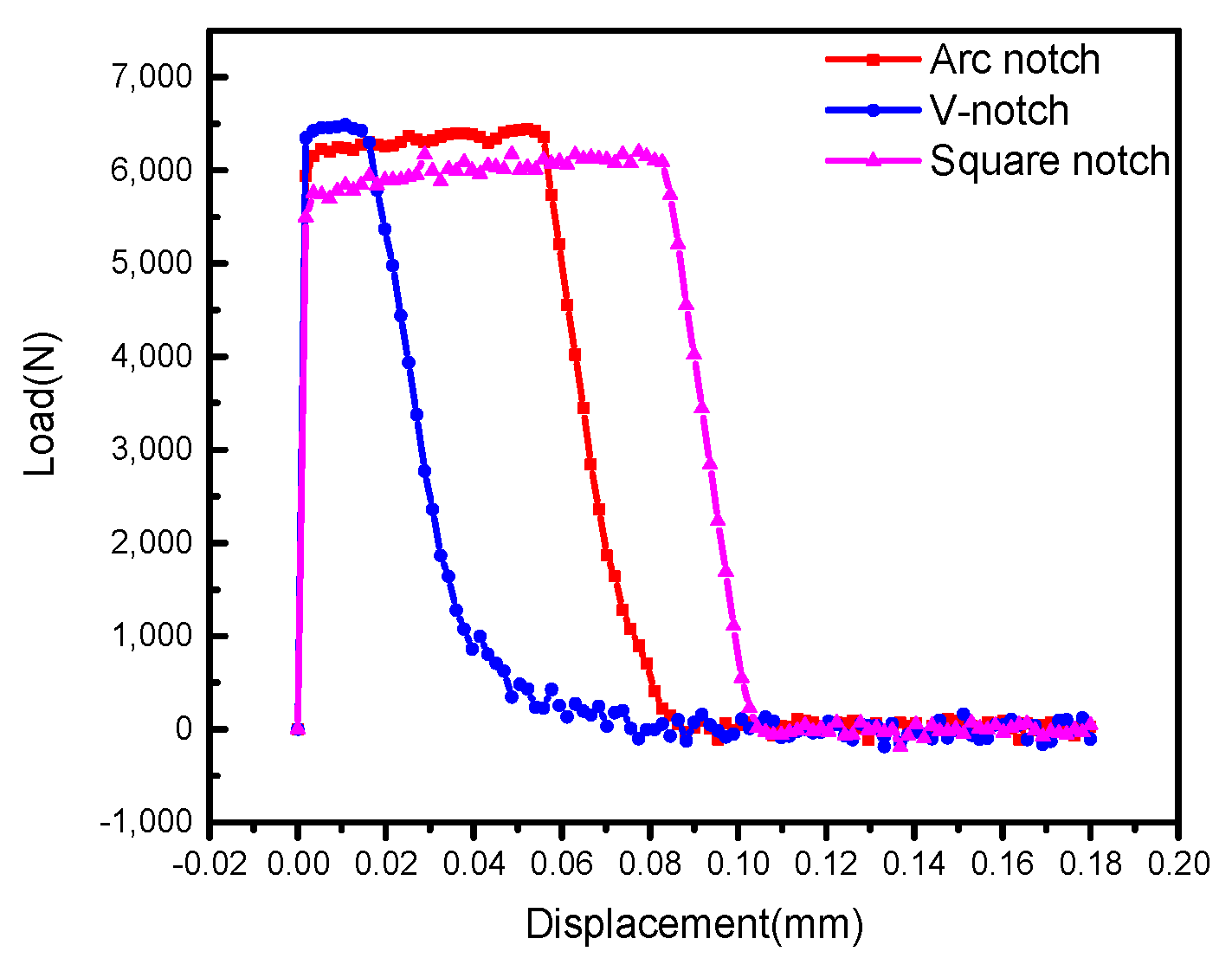

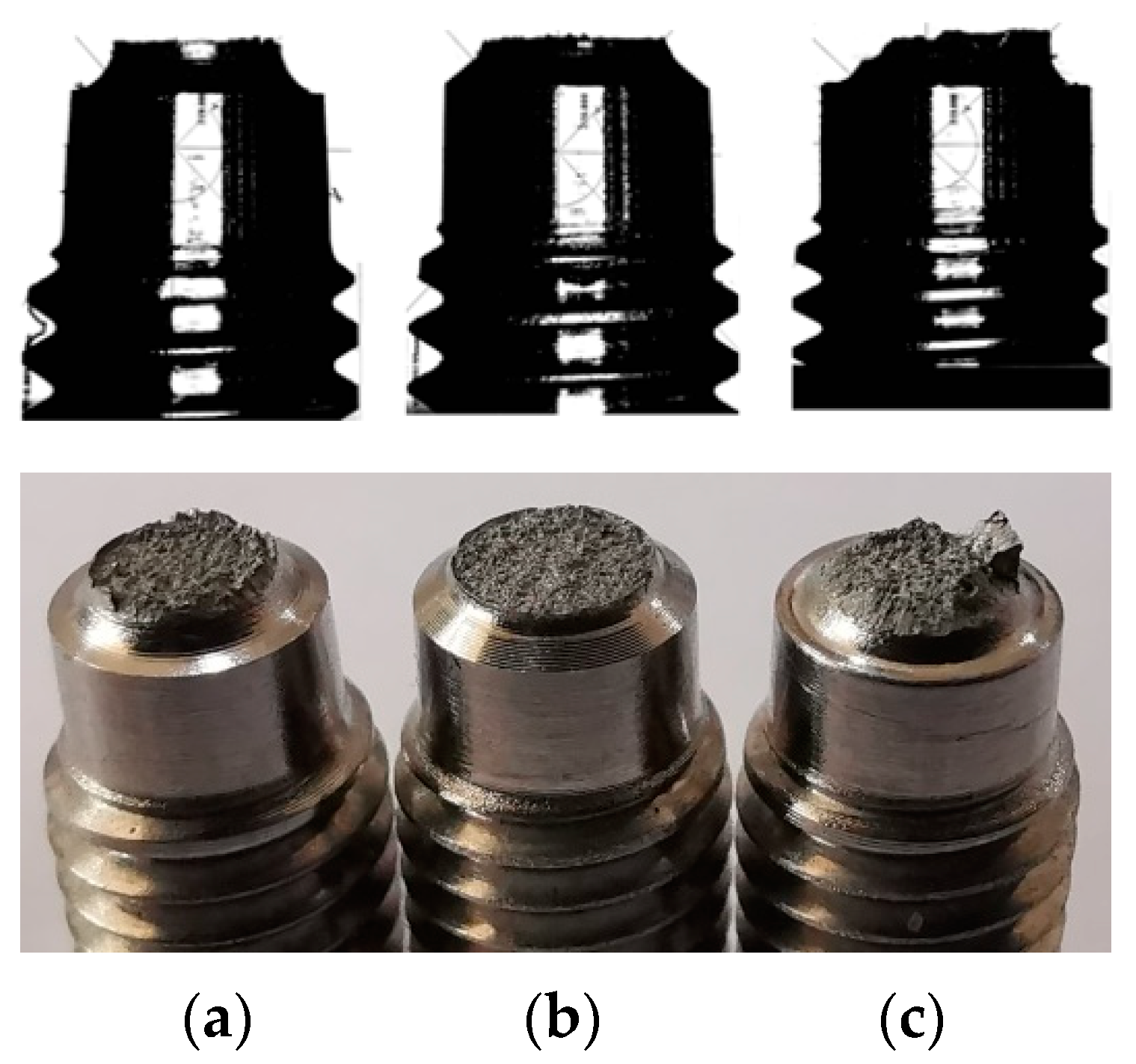
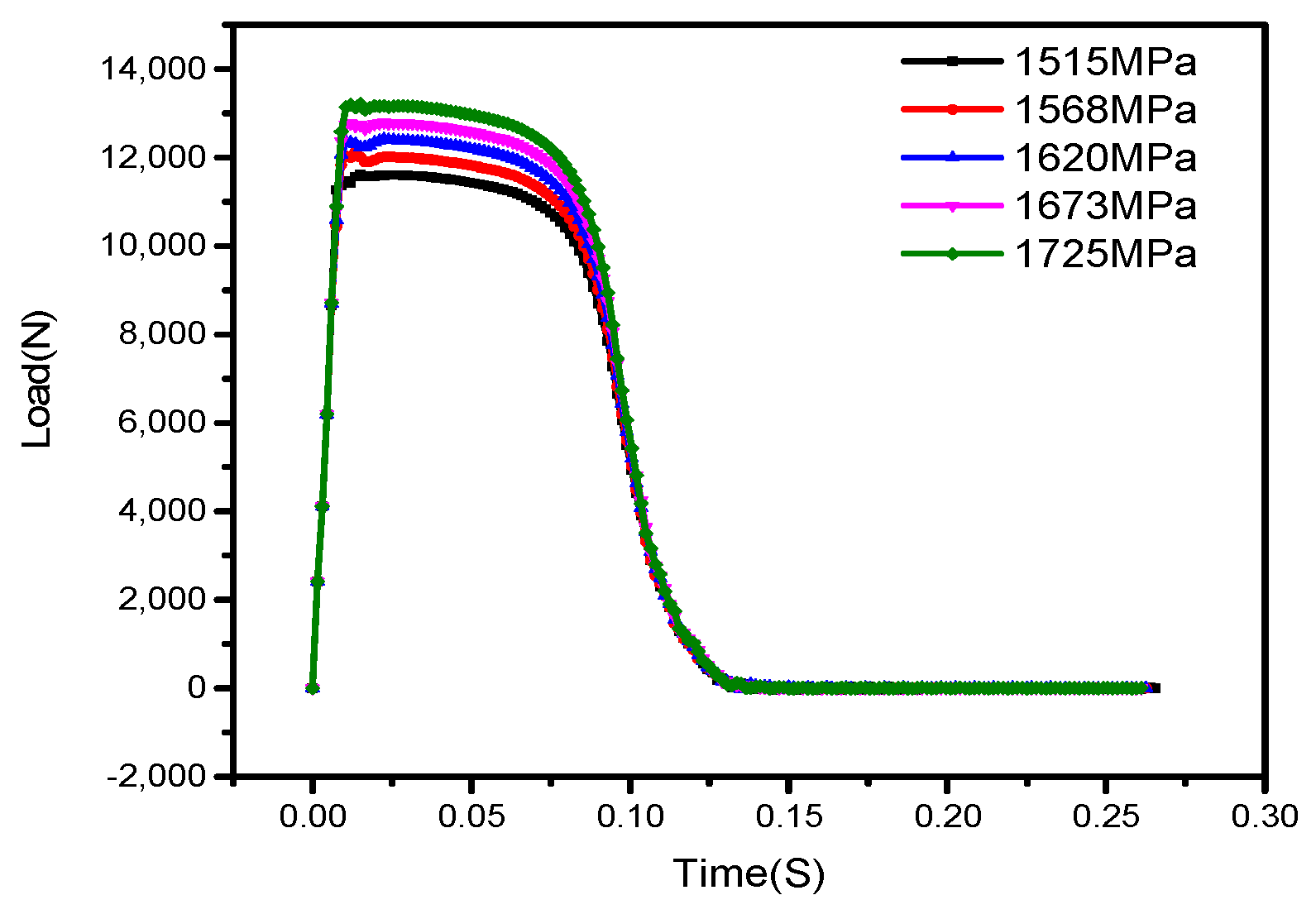
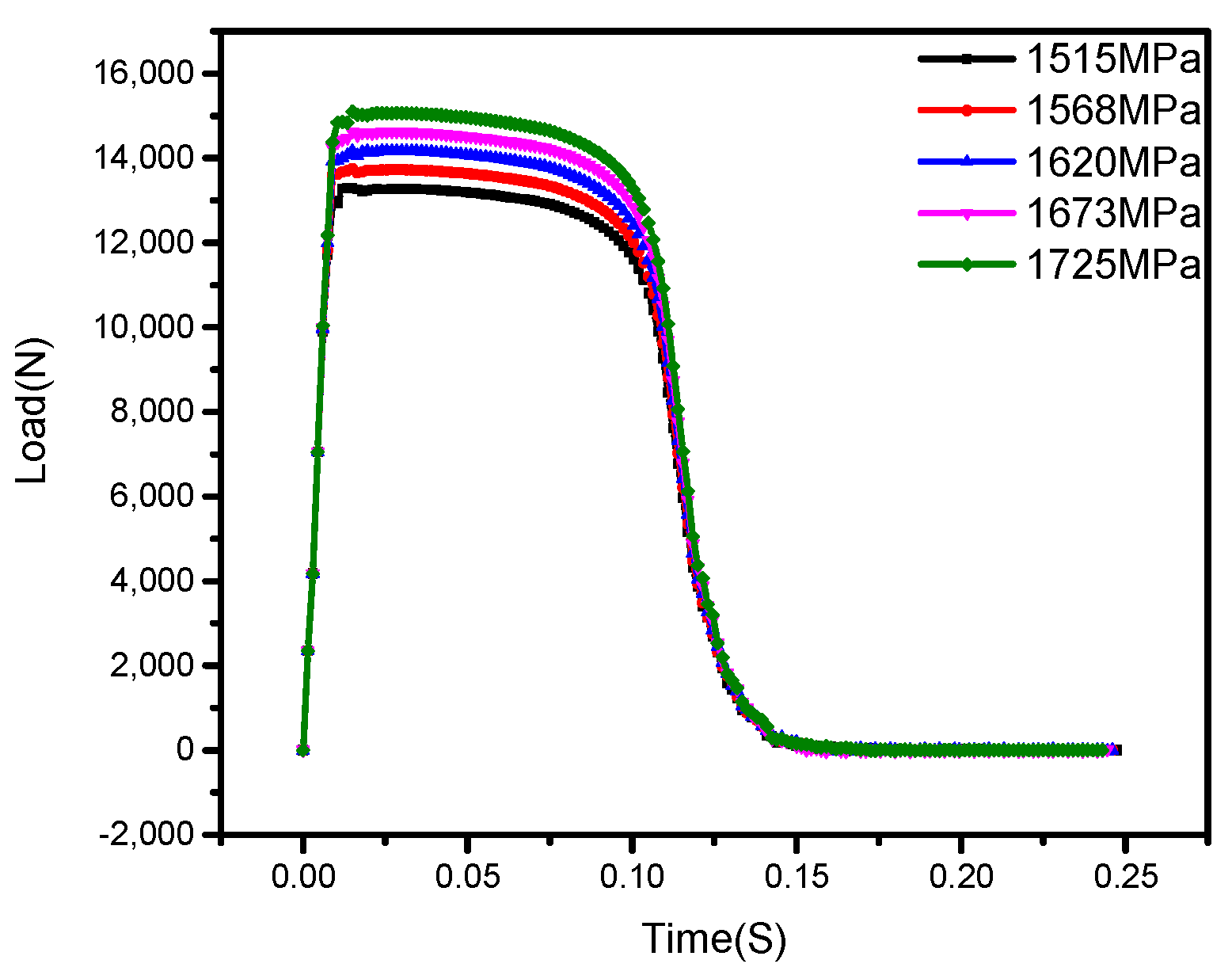
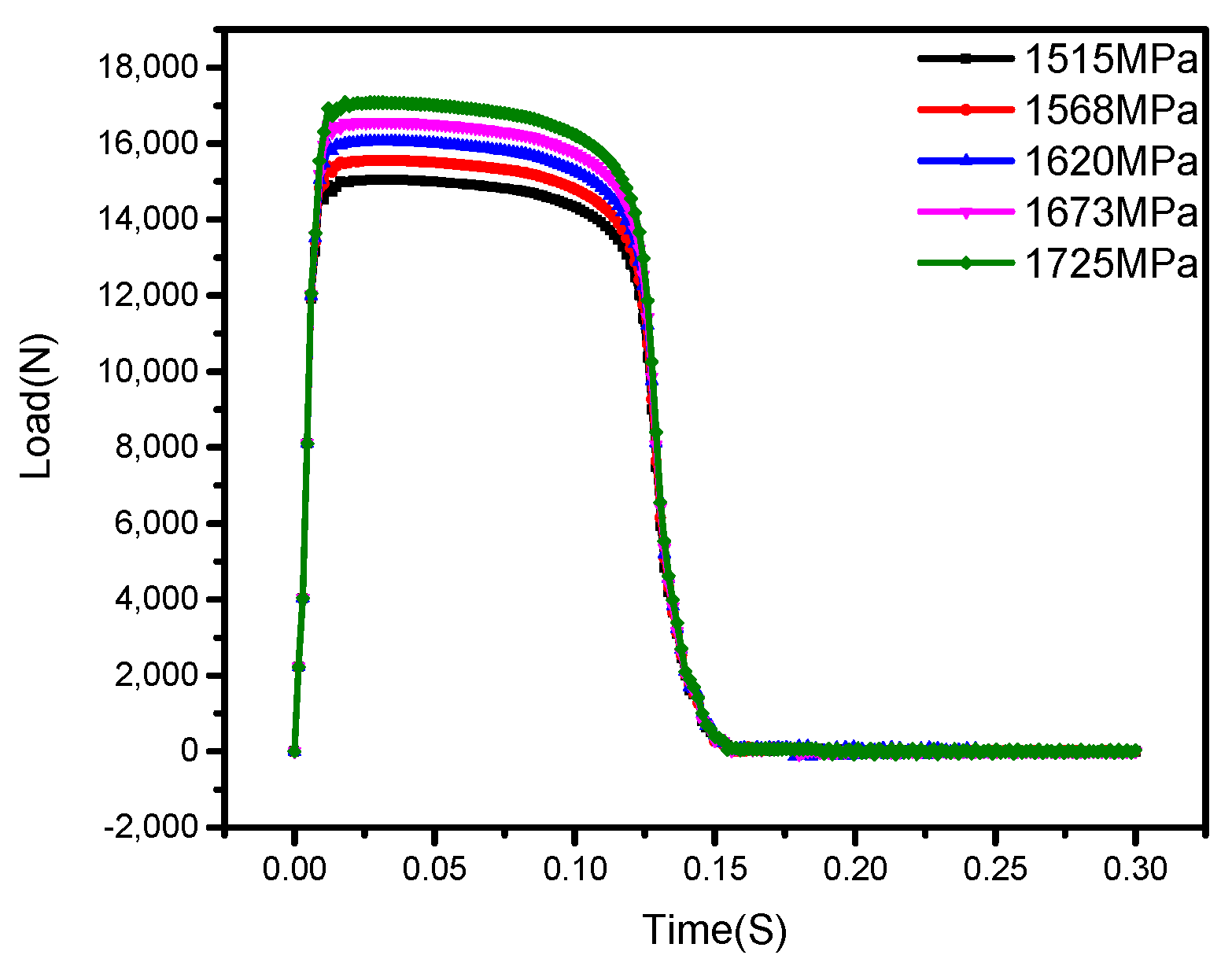
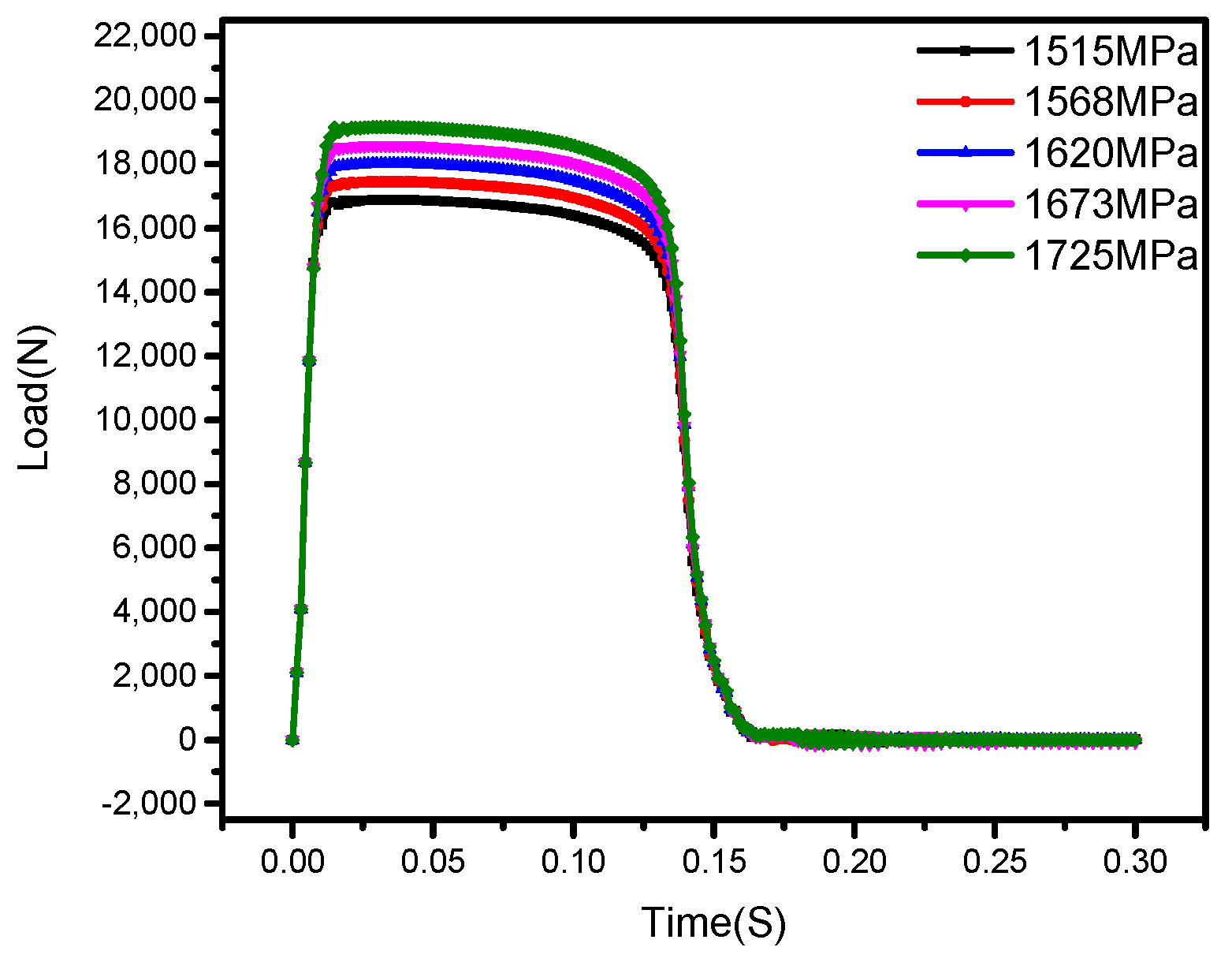
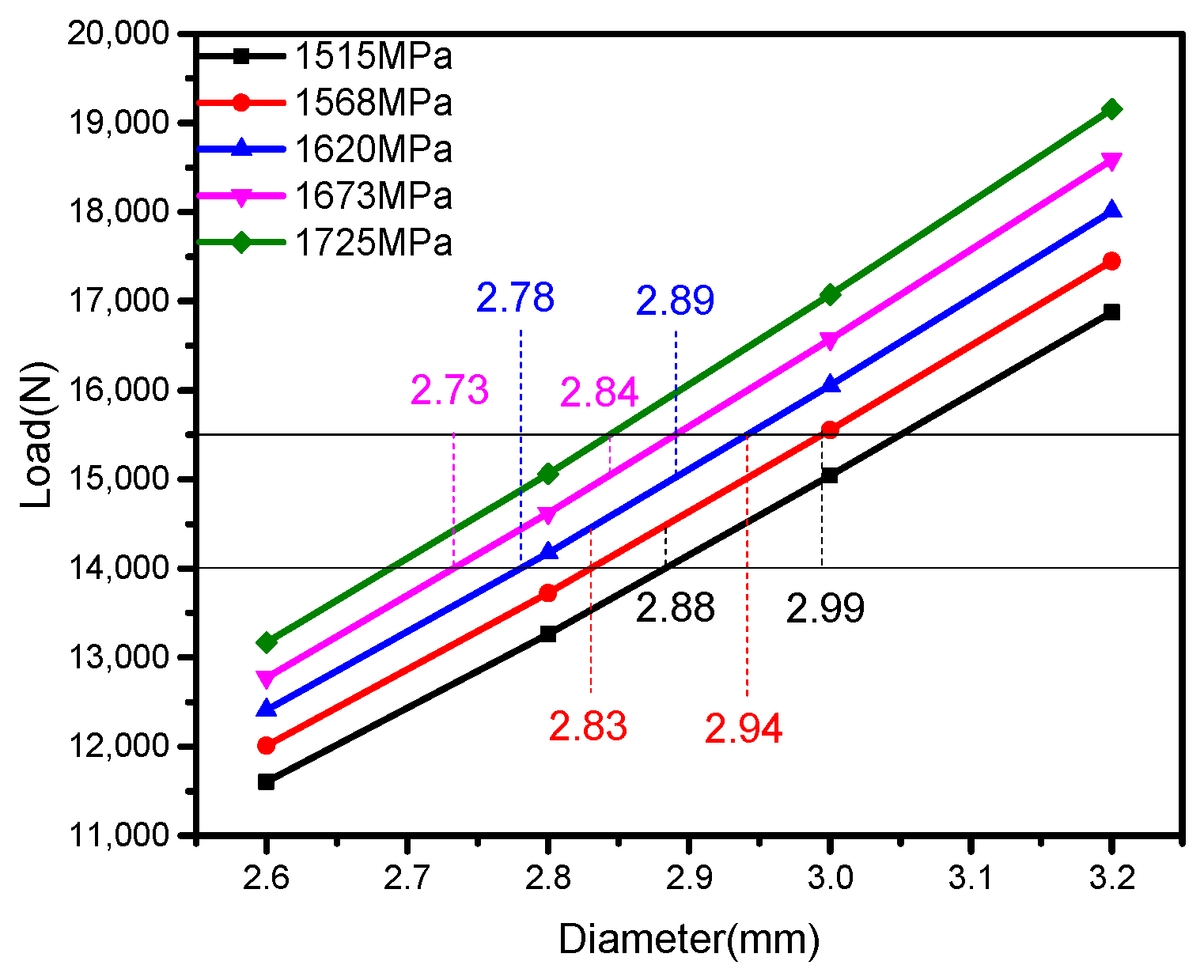
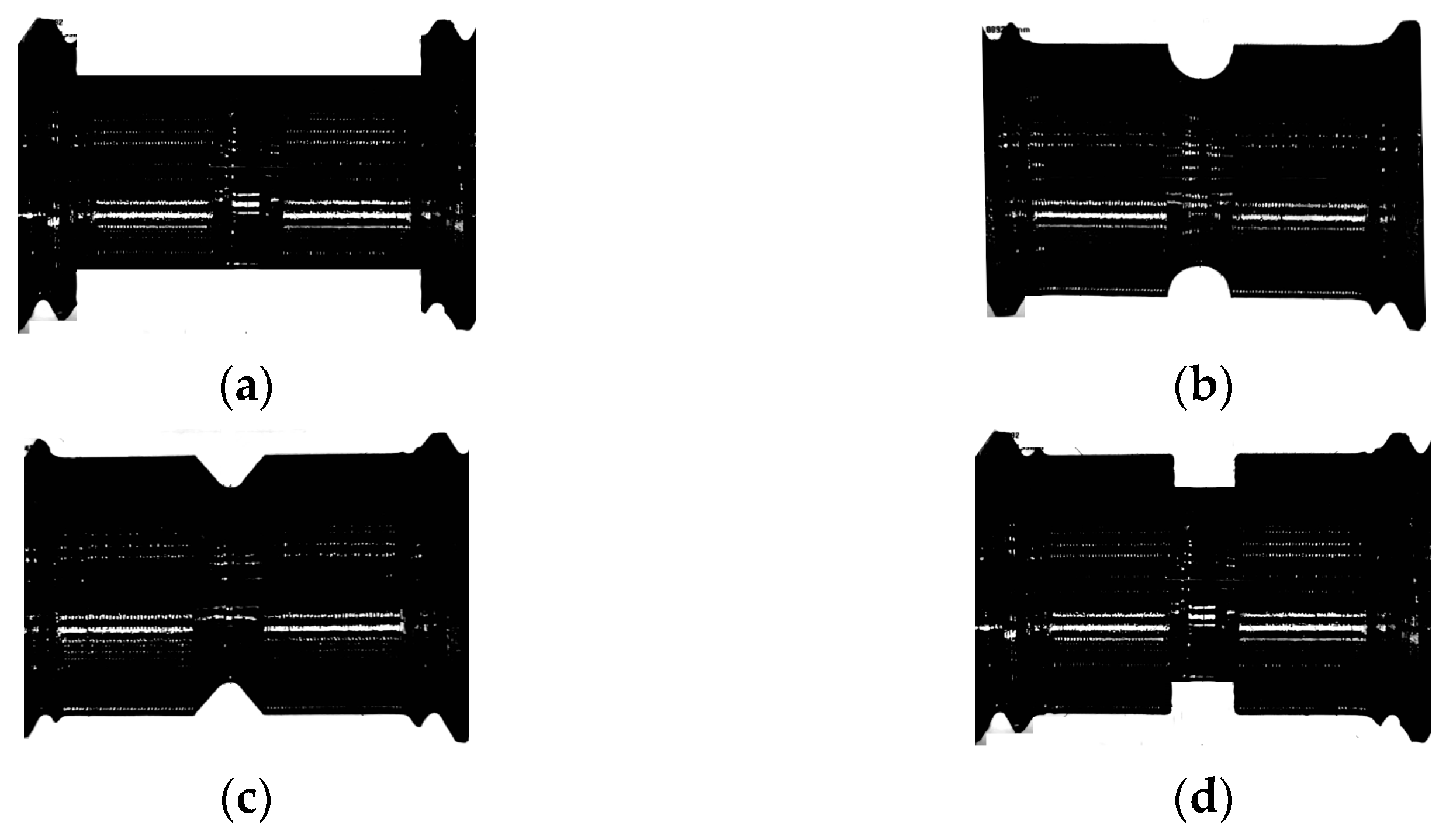
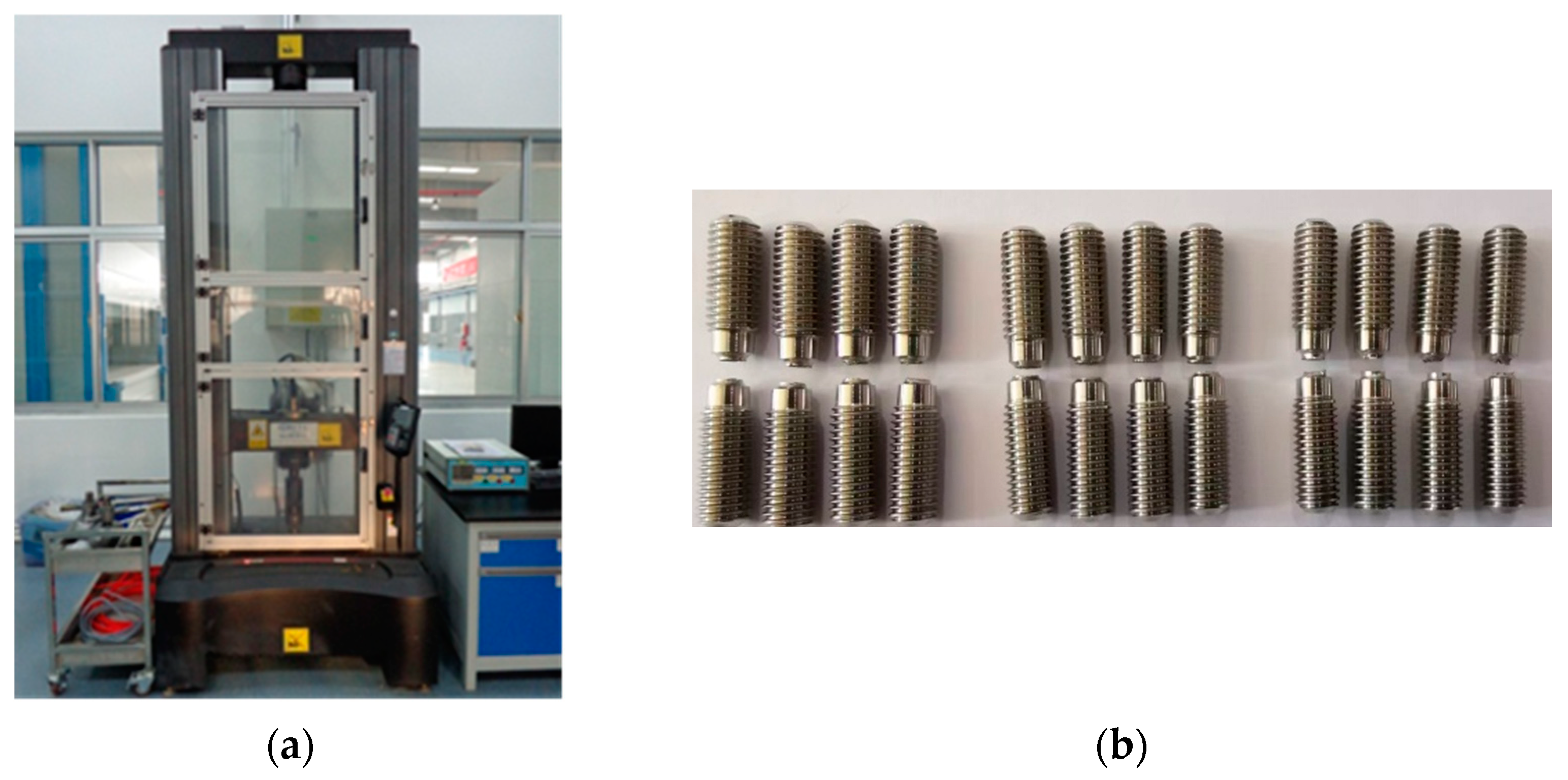
| GH4169 Material Properties | Value |
|---|---|
| Density/(g·cm−3) | 8.24 |
| Young’s modulus (MPa) | 200,000 |
| Poisson’s ratio | 0.3 |
| Yield strength (MPa) | 1516 |
| Tensile strength (MPa) | 1609 |
| Ductile Damage | Value |
|---|---|
| Fracture strain | 0.12 |
| Stress triaxiality | 0.33 |
| Strain rate | 0 |
| Type of Structure | Tensile Load (N) | Tensile Strength (MPa) |
|---|---|---|
| Non-notch | 11,474 | 1623 |
| Arc-shaped | 16,055 | 2271 |
| V-shaped | 17,144 | 2438 |
| Square notch | 14,663 | 2074 |
| Diameter /mm | 1515 /MPa | 1568 /MPa | 1620 /MPa | 1673 /MPa | 1725 /MPa |
|---|---|---|---|---|---|
| 2.6 | 11,606 | 12,011 | 12,411 | 12,774 | 13,168 |
| 2.8 | 13,264 | 13,723 | 14,174 | 14,622 | 15,061 |
| 3.0 | 15,043 | 15,553 | 16,055 | 16,571 | 17,073 |
| 3.2 | 16,877 | 17,451 | 18,012 | 18,590 | 19,156 |
| Bolt Type | Simulated Tensile Load/N | Average Value of Tested Tensile Load/N |
|---|---|---|
| Non-notch | 11,474 | 12,011 |
| Arc-shaped notch | 16,055 | 15,763 |
| V-shaped notch | 17,144 | 16,059 |
| Square notch | 14,411 | 15,090 |
| Notch Diameter/mm | Simulated Tensile Load/N | Average Value of Tested Tensile Load/N |
|---|---|---|
| 2.6 | 12,295 | 12,005 |
| 2.8 | 14,050 | 13,437 |
| 3.0 | 16,055 | 15,763 |
| 3.2 | 17,840 | 17,720 |
Publisher’s Note: MDPI stays neutral with regard to jurisdictional claims in published maps and institutional affiliations. |
© 2022 by the authors. Licensee MDPI, Basel, Switzerland. This article is an open access article distributed under the terms and conditions of the Creative Commons Attribution (CC BY) license (https://creativecommons.org/licenses/by/4.0/).
Share and Cite
Wang, X.; Cui, Y.; Yuan, T.; Wang, X.; Jiang, Z. Effect of Notch Structure and Notch Bottom Diameter on the Tensile Load of a Certain GH4169 Notch Bolt for a Device for Longitudinal Separation of Fairing. Metals 2022, 12, 2127. https://doi.org/10.3390/met12122127
Wang X, Cui Y, Yuan T, Wang X, Jiang Z. Effect of Notch Structure and Notch Bottom Diameter on the Tensile Load of a Certain GH4169 Notch Bolt for a Device for Longitudinal Separation of Fairing. Metals. 2022; 12(12):2127. https://doi.org/10.3390/met12122127
Chicago/Turabian StyleWang, Xiaoliang, Yunxian Cui, Tiebing Yuan, Xiaowei Wang, and Zenghui Jiang. 2022. "Effect of Notch Structure and Notch Bottom Diameter on the Tensile Load of a Certain GH4169 Notch Bolt for a Device for Longitudinal Separation of Fairing" Metals 12, no. 12: 2127. https://doi.org/10.3390/met12122127
APA StyleWang, X., Cui, Y., Yuan, T., Wang, X., & Jiang, Z. (2022). Effect of Notch Structure and Notch Bottom Diameter on the Tensile Load of a Certain GH4169 Notch Bolt for a Device for Longitudinal Separation of Fairing. Metals, 12(12), 2127. https://doi.org/10.3390/met12122127






